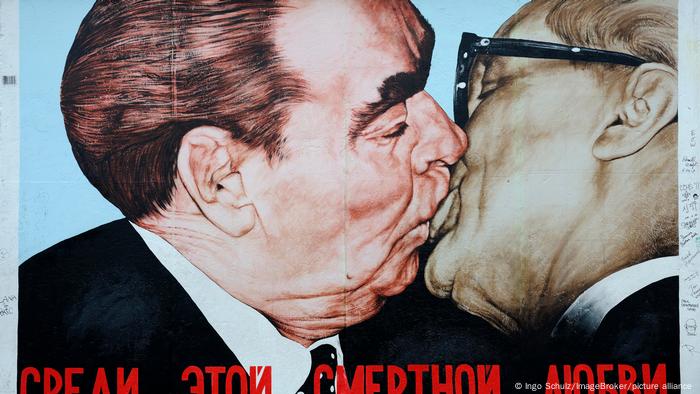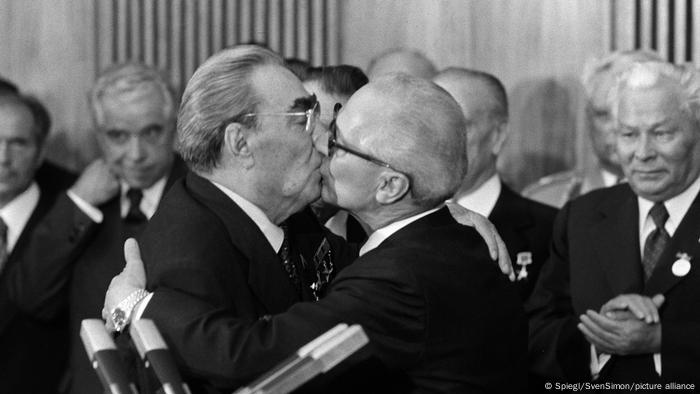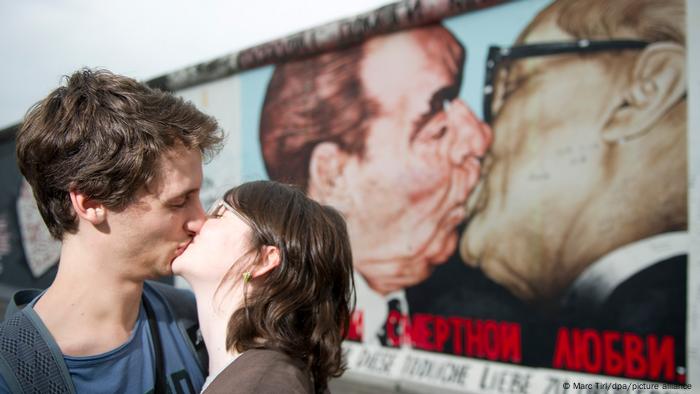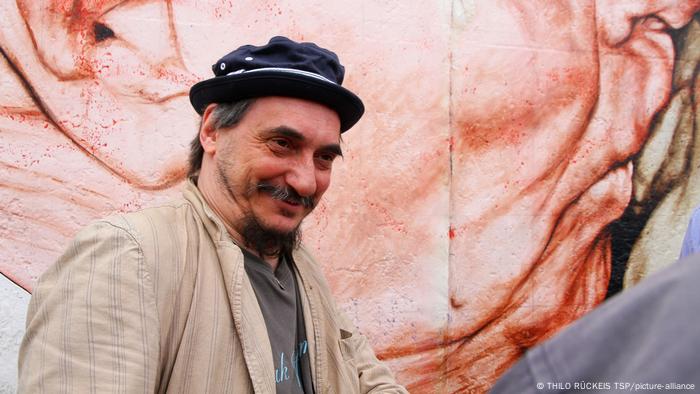
“Brotherly Kiss”, just “Kiss” and even “Kiss of Death”, – are variants of the name of the same graffiti by Dmitry Vrubel, which he wrote on the Berlin Wall. A fragment of the Wall became the basis of the East Side Gallery open-air art gallery in Berlin’s Friedrichshain district. And the image of the Russian artist here is almost the main artifact. Vrubel’s provocative masterpiece captures a passionate kiss between Leonid Brezhnev, secretary general of the CPSU Central Committee, and Erich Ernst Paul Honecker, leader of the GDR.
The artist created the first version of graffiti in 1990 and signed it in Russian and German: “Mein Gott, hilf mir, diese tödliche Liebe zu überleben” or “Sir! Help me survive among this deadly love! “Five artists were invited from the USSR to make the first exhibition of contemporary Soviet art in the GDR. Before the fall of the Berlin Wall, there was only graffiti from the West. Vrubel became one of the pioneers of the East.
The “plot” is borrowed from a photograph by Frankfurter Allgemeine correspondent Barbara Klemm (Barbara Klemm) taken in celebration of the 30th anniversary of the GDR. 10 years before the fall of the Berlin Wall, then General Secretary of the CPSU Central Committee Leonid Brezhnev and General Secretary of the SED Central Committee Eric Honecker sealed the fraternal love between the USSR and the GDR with a long and strong kiss. Graffiti by a Soviet artist ended up becoming one of the symbols of the fall of the Berlin Wall.
The first version of “The Kiss”

New option

historical plot
In 2009, during the restoration of part of the Wall, now known as The East Side Gallery, one of the most striking paintings, has been removed. A serious discussion arose about whether to restore it or not. Most artists did not want to repaint their paintings, fearing that the gallery would become a sort of “Disneyland” for tourists, and that the proceeds for restoration would go into someone else’s pocket. However, Dmitry Vrubel again arrived in Berlin and within a few weeks recreated the “Brotherly Kiss”. Today it is in its old place, inside the city. And it’s this iconic image #25 of the Berlin Wall that is perhaps the most popular photographic motif in the German capital – except perhaps after the Brandenburg Gate and the Reichstag.

Kiss in the background of “Kiss”
vrubel – it’s about “exploding the brain”
In 2010, Dmitry Vrubel with his wife, artist Victoria Timofeeva, and their son moved from Russia to Germany. Recently, they have been developing exhibitions using virtual reality technologies and in 2018 they opened their 3D project to the general public – so that people in cities where there is no Louvre or Hermitage can also participate in the art. “Be in Berlin and show off your work in Russia in virtual reality – this is an incredible feeling”, admitted Dmitry Vrubel in an interview with DW. The artist has always managed to keep up with the times and use new technologies, because “a modern artist must be modern in everything”.
With the help of special computer programs, the creative ensemble of Vrubel and Timofeeva created exhibition spaces and “hung” paintings in them. The lack of censorship, the ability to show art with political overtones, and the wide availability of 3D exhibitions are the main reasons artists turn their work into virtual reality. The exhibition is available on the platform Steam. With the help of virtual reality glasses, you can see about 100 monumental life-size paintings: the Tolstoevsky project, the Gospel project, the Artist’s Diary, as well as the reconstruction of an exhibition of apartments from Soviet times. The tour is “led” by Dmitry Vrubel’s avatar – a lithe guy in a t-shirt, jumping from photo to photo and emotionally waving his arms. Dmitry Vrubel’s plans included the creation of the “Museum of the Event”, which was supposed to cover and understand important news from an art point of view.
The artist dreamed of becoming the biggest art space in the world… Lubyanka! “The first major exhibition of Russian contemporary art must be in the Lubyanka – as in buildings”Stasi.” Lubyanka should become the biggest artistic occupation in the world. But first, you need to get all these documents from the “Reich Chancellery” to file,” joked Dmitry Vrubel in an interview with DW.
How a Russian Artist Became a German Pirate
To be closer to the problems of ordinary Germans, shortly after moving to Berlin, Vrubel joined the “Pirate Party”. “Pirates” advocated the legalization of “piracy” on the Internet, soft drug policy, the introduction of suffrage for all residents of Germany (regardless of citizenship), and so on. “They are close to me in spirit, because they want to actively change society and solve problems that traditional parties cannot think about due to their conservative thinking,” Vrubel commented of his decision at the time.

Dmitry Vrubel
The artist considered the integration of Berlin through cultural intervention his “horse”. “Where the East Side Gallery is, it used to be a wasteland. After the artists painted the wall, Berlin started to come together in this place. Now it’s a trendy area,” Vrubel said. “The fact that people in so-called problem areas are not interested in contemporary art is the problem with contemporary art,” he said. Art moved away from people, and so the artist sought to bring them together – as in Werner Herzog’s Fitzcarraldo, in which the eccentric adventurer played by Klaus Kinski wants to build an opera in the jungle. But Vrubel was serious and at the same time – without anger and vanity.
An intellectual-dreamer from a dissident environment
Dmitry Vrubel was born in 1960 in Moscow into a family of engineers and started drawing as a teenager. At age 20, he joined the Artists’ Union and, a few years later, opened his own gallery, naming it after him. In the 1970s and 1980s, he, like many fellow artists who are now called conceptual artists, organized exhibitions in his apartment or studio. At that time, he mainly created large-format portraits. His, perhaps, the most provocative masterpiece of the Berlin Wall, the artist wrote at age 30.
“I would like to live in Moscow as I live in Berlin. Berlin – this is an ideal Moscow. But under the current government of Russia, it is very difficult to engage in political art. And art outside the political context doesn’t interest me”, admitted the artist.
Since 2010, Vrubel lives permanently with his wife in Berlin, where they created an open workshop. The artist has had many solo and group exhibitions around the world. His works are shown in the most famous museums. Berlin became Vrubel’s second home, and “The Fraternal Kiss” glorified the USSR-born artist across the world. Many of those photographed today against the backdrop of Vrubel’s masterpiece may not even know who these people are on a fragment of the Wall and why secretaries-general kiss. And young tourists are unlikely to remember the sad details of socialist friendship, but they won’t forget the short name: Vrubel.
Source: DW
Lori Barajas is an accomplished journalist, known for her insightful and thought-provoking writing on economy. She currently works as a writer at 247 news reel. With a passion for understanding the economy, Lori’s writing delves deep into the financial issues that matter most, providing readers with a unique perspective on current events.